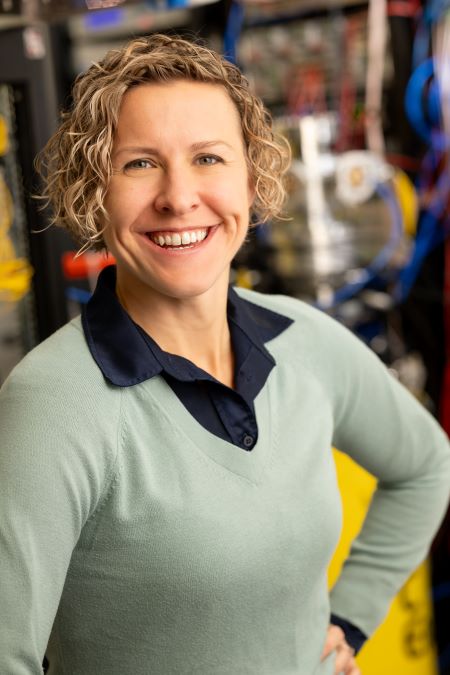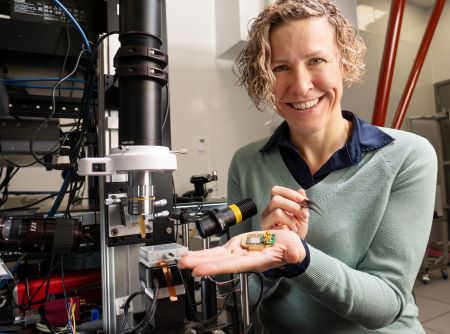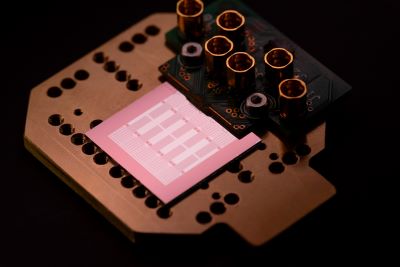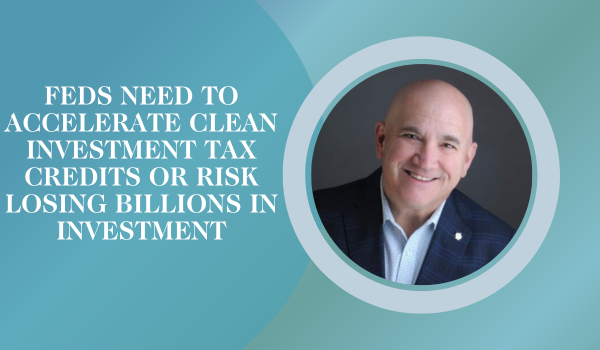Quantum systems builder: Q&A with Stephanie Simmons, chief quantum officer at Photonic
Burnaby, B.C.-based Photonic Inc., a seven-year-old startup which is building a quantum system emerged from “stealth mode” earlier this month. Photonic announced US$100 million (Cdn$137 million) in venture capital from Microsoft Corp. and other investors – and a new partnership with Microsoft.
Photonics is building a quantum system using silicon chips whose quantum properties can be transmitted and manipulated using light. This opens up the possibility of building a distributed network of chips connected by optical fibres to perform quantum calculations, instead of having a single, large quantum processor.
In principle, a quantum system could break encryption codes used to protect financial and other information, while providing a new form of impenetrable encryption. Quantum systems also could be used – among many other applications – to predict the behaviour of molecules and help discover new materials or drugs, more accurately forecast weather and model climate change, or optimize decision making in dynamic situations, from financial situations to traffic or electricity grids.
 Photonic was founded by Dr. Stephanie Simmons, PhD (photo at right), who grew up in Kitchener, Ontario, and Dr. Michael Thewalt, PhD, professor emeritus of physics at Simon Fraser University. Simmons, after earning a PhD in material science at Oxford University, studied electrical engineering at the University of South Wales in Sydney. She moved to Vancouver in 2015, teaching physics at Simon Fraser University and founding Photonic in 2016.
Photonic was founded by Dr. Stephanie Simmons, PhD (photo at right), who grew up in Kitchener, Ontario, and Dr. Michael Thewalt, PhD, professor emeritus of physics at Simon Fraser University. Simmons, after earning a PhD in material science at Oxford University, studied electrical engineering at the University of South Wales in Sydney. She moved to Vancouver in 2015, teaching physics at Simon Fraser University and founding Photonic in 2016.
Simmons, chief quantum officer at Photonic and who’s also co-chair of the advisory board to Canada’s National Quantum Strategy, talked with Research Money’s managing editor Mark Lowey about Photonic’s technology, the new partnership with Microsoft, her vision for building Photonic in Canada, and what inspired her to build her own quantum computer.
R$: Venture capital financing is tight these days, yet Photonic managed to raise US$100 million What do you attribute that to?
Dr. Simmons: Usually what you look for when you raise capital is team, technology and traction. You could put big circles on each of those for where we are. We have an exceptional C-suite and leadership team, but honestly it’s the people making stuff happen on the ground. When we were doing the due diligence, we were sharing how far we’ve come in such a short time and it did have this universal jaw-drop response [from potential VC funders], which is super helpful. If anything, the team is what makes it all possible.
The technology is really the promise of where it’s going. It has been this missing link in quantum technology development to think about the systems engineering of scalable quantum. What does that actually look like? There are many, many quantum systems out there that are really doubling down on their specific ingredients, but not coming at it from a systems engineering perspective. As soon as you start thinking about how the system needs to be put together, you really only have a few things that can tick the boxes. And that’s directly in line with how classical computing has gone, where the network is the computer. You need to think about modularity, about networking your systems together. We have a unique value proposition along that direction. We think it’s pretty special. It’s one of these “Ah-ha!” moments. This is where it’s going, this is how you actually bring quantum to scale.
The third [factor] is traction. One of the most exciting collaborations in this space is the one that Photonic just struck with Microsoft. That is in some sense the best possible traction one could imagine. They did extensive due diligence on [our technology]. They know exactly what this looks like. And they are perfectly placed as go-to-market collaborators for this kind of work. You can’t really get traction better than that, before we hit these large-scale photonic systems. How else can you point to traction, other than to have a team like Microsoft who knows exactly what they’re talking about in this space, attest to what that’s going to mean for future value, and willing to put money where their mouth is.
R$: Along with its VC raise, Photonic also announced a collaboration with Microsoft. What’s the purpose of this collaboration and what do you hope it will achieve?
Dr. Simmons: In the quantum computing space, it remains an open question what you would do with a large-scale, fault-tolerant, reliable quantum system. What would you charge for it? Who would you go and market it to? There is nobody better placed in terms of thinking about that strategy than the one company [Microsoft] that basically has everybody as its customer base and has been thinking about the value proposition at the algorithm level for a long, long time.
How many different industries are going to be impacted by this and who’s going to jump in first and what matters to them in terms of their workflows and how do we fit in and solve their problems? This collaboration is about going faster together on all kinds of quantum technologies and then having a really close loop with the customer base who wants to make the most of it, because it’s going to be a very interesting phase when these things come online. Who is going to want them most? What are they going to do with them and how is that going to work? Alongside Microsoft, we can work with customers in advance of these things coming online. It’s about going faster and hitting value.
This [partnership with Microsoft] is very much focused on development. Yes, there is still research but it is professional engineering and development, so it is really that side. And it’s that broader reach: how do we think about going faster everywhere up and down the stack and going faster with customers, thinking very carefully about how even just co-designing for their specific application. At this point, that market development really hasn’t been done because people haven’t seen scalable, fault-tolerant [quantum computing systems] on the horizon. People have been thinking about how do you make use of small-scale quantum systems and maybe there are some optimization improvements that could be made there.
But now it’s really clear in everyone’s focus, for example: ‘I want to design this battery. It’s going to require this number of elements, it’s going to need these many qubits, and I’m willing to pay this many dollars for that information.’ Then we have to do that use-case development, that application engineering for all the possible users of this technology, because we at the moment don’t have a clear market map of who’s willing to pay the most for those scarce initial resources. What’s the most value you can bring to the table? And should we be co-designing for that app in particular? There are opportunities to design all the way down to the hardware to best optimize, say, a chemical simulation. If that ends up being the thing that drives the most value in the short terms, that is a flywheel for everything else in the space.
R$: Many people I talk with tell me that Canada really can’t compete with the U.S. and some other countries with deep pockets, or with the multinationals, in building a commercial, practical quantum computer. And that Canada should focus instead on developing applications for a quantum computer that somebody else will build. What is it about Photonic’s technology – especially the company’s novel architecture for a quantum system – that convinces you that Photonic can compete in this space?
Dr. Simmons: Just watch me do it! Money is global, opportunity is global, workforces are global. It’s a recruitment play, so talent wants to be where talent lives. And Canada wins at that metric. We should be using that. From a quality of life perspective, people want to work here. I think it’s important to work with like-minded allies. There is no reason why we can’t win. We’ve won many times before. We are the home of Bombardier, the home of the Candu reactor, the Avro Arrow – there’s nothing saying we can’t do it. So I have no problem having a go.
 Our technology’s novel architecture is totally crucial [to being able to compete]. Other companies are working with silicon, but they’re not working where we are. There are a whole bunch of spin-only players, and that includes Intel, Dirag [in Australia] Quantum Motion [in London, U.K.] and some startups. And then there’s the pure photon game where they’re only using photons and they don’t use [spin-photon interfaces] for providing solid state memory. Those companies include PsiQuantum, Xanadu and a few other players. We’re the only ones that are doing spin-photon interfaces. We went down this path because the issues of one [component] get solved by the other. The connectivity of spins is solved by photons. And the loss of photons is solved by having a solid state memory. Once you point that out, it does resonate for a lot of people. At the moment, we’re the only ones in
Our technology’s novel architecture is totally crucial [to being able to compete]. Other companies are working with silicon, but they’re not working where we are. There are a whole bunch of spin-only players, and that includes Intel, Dirag [in Australia] Quantum Motion [in London, U.K.] and some startups. And then there’s the pure photon game where they’re only using photons and they don’t use [spin-photon interfaces] for providing solid state memory. Those companies include PsiQuantum, Xanadu and a few other players. We’re the only ones that are doing spin-photon interfaces. We went down this path because the issues of one [component] get solved by the other. The connectivity of spins is solved by photons. And the loss of photons is solved by having a solid state memory. Once you point that out, it does resonate for a lot of people. At the moment, we’re the only ones in  that colour centre space.
that colour centre space.
(Colour centres are defects in the structure of solid materials that allow photons to interact with electronic spin properties of the material. Their integration with waveguides – devices that guide light – can be used to connect operations across a quantum processor).
What we’re really excited about is to share an architecture (photo at left) that applies to all of those [potential applications]. You really do want to leverage telecom and silicon. From a competitive standpoint, it really does open up a lot of opportunities, to do it that way.
R$: What is the stage of development of Photonic’s quantum computer and platform – how far along are you and when do you expect to have a working prototype?
Dr. Simmons: We certainly have prototypes now, but I’m not going to be able to share specifications. It’s really within five years I think this is all going to play out. In some sense, we’re standing on the shoulders of giants. The spins in silicon have already shown all kinds of performance metrics which are astounding. The spins are just gorgeous, gorgeous qubits. That’s another reason [for Photonic’s technology architecture] – it’s not just from a commercial perspective or a quantum perspective. So it is a foot race [getting to a large-scale, fault-tolerant, reliable quantum system], it is really, really fast. But we know what we need to do. There’s work to be done but it’s not too intimidating. You can take solace in the fact that now that we’re out of stealth and actually communicating, at some point we will be sharing technical metrics as well.
R$: What inspired you to want to build your own quantum computer – where did the spark come from?
Dr. Simmons: Impatience, actually. I was brought up coding computers. I loved it, I loved making computers do stuff when I was playing on my old 386 when I was a really young kid (The Intel 386, a 32-bit personal computer launched in 1985 offered then-high-speed processing. The first versions had 275,000 transistors and were the central processing unit of many workstations and high-end PCs of the time). When I came across the concept that there exists a richer form of computation – and I’ve seen how much it has changed the world – I wanted to program quantum computers. I wanted to be a programmer. So I got into that. I was in the space for a few years and it became evident that they [quantum computers] weren’t anywhere on the near-term horizon. So I got impatient. I said, ‘Fine, how hard can it be [to build a quantum computer]? Let’s go do it.’
At that time, I did not expect that I would play a leading role in a new architecture for quantum. I just wanted to go and help. But as I was in that space for long enough, nothing really felt intuitive. It all felt like there was something intrinsically wrong about most of the approaches out there – for scalability reasons more than anything. You have to be in a regime where it’s not harder to add components. It has to get easier. Otherwise, it doesn’t truly scale. It’ll get big but it will be self-limiting at some point. Nothing was really working to have that longer-term picture. So that’s why I went down this direction: okay, how do we merge networks and computing? That was the thing I think that’s been missing, is people have been thinking about these topics as separate objects. They’re really not separate objects. It’s all about [quantum] entanglement distribution. For both technologies, the more entanglement distribution you get, the better they perform. That’s the core thing. That’s why I think these are unifying technologies.
(Quantum entanglement is when two particles or quantum objects link together in a certain way no matter how far apart they are in space. Entanglement is when one of these particles mirrors the other’s properties and behaviour, regardless of the distance between them. Entanglement distribution is a necessary ingredient and a key functionality of a quantum network, because it allows multiple states to be acted on simultaneously, unlike classical bits, 1s and 0s, that can only be acted on independently).
.jpg) R$: A lot of Canadian companies that are world leaders in specific technologies and grow to a certain size end up being bought – along with the company’s IP and talent – by a foreign entity, often in the U.S. What’s your vision for Photonic: do you plan to avoid this fate and remain in Canada and grow Photonic here and, if so, how do you intend to do that?
R$: A lot of Canadian companies that are world leaders in specific technologies and grow to a certain size end up being bought – along with the company’s IP and talent – by a foreign entity, often in the U.S. What’s your vision for Photonic: do you plan to avoid this fate and remain in Canada and grow Photonic here and, if so, how do you intend to do that?
Dr. Simmons: There are models for success where firms can exist in smaller countries, because it’s not just in Canada. The broader point is you have to be very eyes-opened. You have to think about having more than one base of operations. You have to have deep connections to multiple geographies. This is a dual-use technology, so it’s of utmost importance to the largest security services around the world as well.
By dual-use technology, I mean quantum systems will be able to implement Shor’s algorithm. And Shor’s algorithm can basically walk its way into any [computer] cryptography at the moment. (Shor’s Factoring Algorithm can factor numbers exponentially faster than any known classical algorithm). Correspondingly, already you can tell that [quantum computing] is going to be a regulated industry, because you’re not going to give God-like information access over the cloud just for a fee. That’s just not something that is going to be allowed. Therefore, it’s also going to be tightly controlled technology because of its uses on the military side of things. That’s why it’s important to figure out what the value is for the non-military aspects and really clarify that, so it’s not as a technology consumed by the military applications. Nevertheless, you can’t be naïve and pretend that doesn’t exist. You have to be able to talk to all the people and make sure everybody’s on the same page. And in doing so, you stand the best chance.
I also would push back on the assertion that the times we’ve built industries and they’ve been acquired that those are failure modes. If you look at the telecom boom of Ottawa, I think [the telecom industry] is a much stronger position today even without Nortel because of what it did for that entire industry and all of the companies that came afterwards. Frankly you could point to Silicon Valley and say Fairchild Semiconductor was a failure. But that doesn’t mean that the ecosystem it put down wasn’t wildly successful and continues to be wildly successful.
(Fairchild Semiconductor International, a semiconductor company based in San Jose, California, became a pioneer in the manufacturing of transistors and integrated circuits. Gordon Moore and Robert Noyce, two founders of Fairchild, left the company and in 1968 started Intel – short for Integrated Electronics – now headquartered in Santa Clara, California. It is one of the world’s largest semiconductor chip manufacturers by revenue).
I think [Photonic’s work] really can be a long-term beneficiary, regardless of what the particular corporate outcome is, so long as the ecosystem mobilizes. The fact that we have tech hotbeds and people have well-paying jobs here from a lot of these companies even if they got acquired – they don’t all uproot. The ecosystems have a good role there. We live in a capitalist society, we can’t be naïve. At the same time we can really invest in ecosystems, especially when it comes to a physics-based play like this. Manufacturing will matter and if you get in front of that and have that entire supply chain, you can do really excellent things. Small countries can absolutely support globally dominant anchor companies, which in turn develop strong and mostly local supply chain ecosystems, such as TSMC (Taiwan Semiconductor Manufacturing Company) or Nova Nordis (a global healthcare company headquartered in Denmark). Nortel absolutely had this global status and supply chain local ecosystem, too, back in the day.
I came back to Canada for the talent play and the IP play and to have a go. It would have been a different story if I started somewhere else. You have to try. The boundaries between countries are getting weaker. Most companies are international to some level now anyway. The world is changing and we have to do our best. First, we still have to make the [quantum system]. We still have to deliver on all the excellent things and all the ideas that we have in our heads. That’s the most important thing. Let’s build it and then we can deal with all the opportunities that come downstream.
R$
Events For Leaders in
Science, Tech, Innovation, and Policy
Discuss and learn from those in the know at our virtual and in-person events.
See Upcoming Events
You have 0 free articles remaining.
Don't miss out - start your free trial today.
Start your FREE trial Already a member? Log in
By using this website, you agree to our use of cookies. We use cookies to provide you with a great experience and to help our website run effectively in accordance with our Privacy Policy and Terms of Service.




